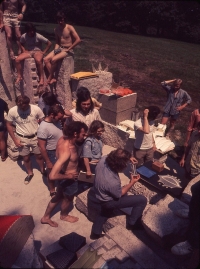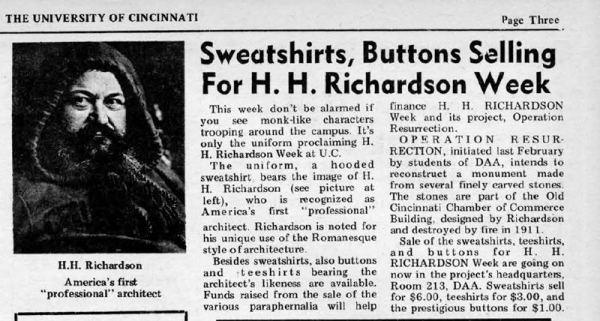UC Magazine recently published a story celebrating the Richardson Stones in Burnett Woods. Read the story below or to view the original story, go to magazine.uc.edu/favorites/web-only/richardsons_rocks.html You can also find a collection on the Richardson Stones at the Archives and Rare Books Library. The finding aid is available on the OhioLINK Finding Aid Repository.
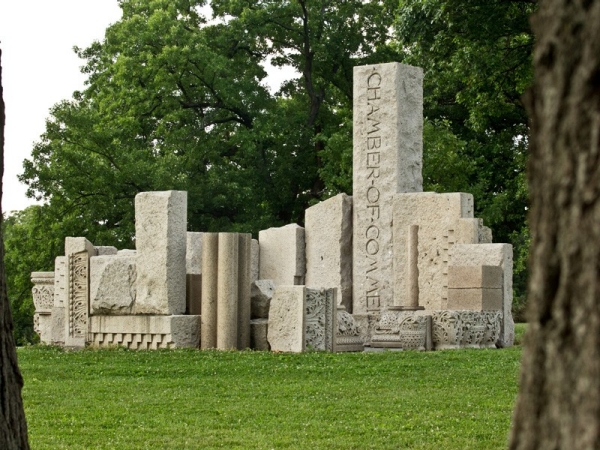
UC architecture faculty and students who integrated H.H. Richardson and his works into their ongoing studies completed this memorial in Burnet Woods Park in 1972. photo/Jay Yocis
Former UC architectural history professor Bill Rudd shares the story behind the student-led construction of the Burnet Woods memorial to famed architect H.H. Richardson’s Cincinnati Chamber of Commerce Building. Henry Hobson Richardson is highly regarded, along with Louis Sullivan and Frank Lloyd Wright, as one of “the recognized trinity of American architecture.” The style he popularized is named for him: Richardsonian Romanesque.
Among the last buildings Richardson designed was the one-time Cincinnati Chamber of Commerce building on 4th Street. That building, dedicated in 1889, would stand among the most significant public structures in the region — along with works like the Suspension Bridge, the Carew Tower, City Hall, Music Hall and Union Terminal — had it not been destroyed by fire a century ago, in 1911. The memorial was completed in 1972.
The tale of UC’s ‘Operation Resurrection’
By J. William Rudd
The story of how Richardson’s Rocks came to be built in Burnet Woods actually begins in the fall of 1965 when I joined the then Department of Architecture in UC’s then College of Design, Architecture and Art (DAA), the forerunner to today’s DAAP.
My primary responsibility was to teach the history of modern architecture; however, I naturally studied architectural history, including archival records — newspaper articles and architectural periodicals — available in the Cincinnati Historical Society relating to Richardson’s Cincinnati Chamber of Commerce building.
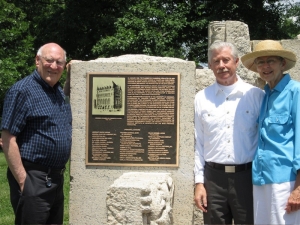
Left to right: Former DAAP professor Bill Rudd, memorial designer Stephen Carter, DAAP '69, and Mary Peterson, widow of emeritus architecture professor John Peterson, pose with the recently re-installed plaque at the Richardson Memorial and Chamber of Commerce Monument in Burnet Woods.
This led to my publishing a history of the building in the May 1968 issue of the “Journal of the Society of Architectural Historians.” My most important finding, however, was the history of the building’s stones following the fire. There were indications that the stones were still in the area but where?
I routinely brought students up to date on my findings regarding the building’s competition, construction, dedication and demise, and my curiosity about the stones and their possible existence still in the local area.
Ironically, a DAA colleague in industrial design, Roland Johnson, then president of the Cincinnati Astronomical Society, provided me with a work that had previously been privately published by the society: “Richardson: The Architect and the Cincinnati Chamber of Commerce Building.” That work finally led to locating the stones from the burned building. They were in Cleves, along Buffalo Ridge Road.
At about this time, I accepted a faculty position in the School of Architecture at Syracuse University (before later returning to UC); however, my research on Richardson’s Chamber of Commerce building continued.
In fact, the story of the building provided the content for a paper I presented at the 1967 annual meeting of the Society of Architectural Historians. The presentation was the last in a session on the architecture of H. H. Richardson. At the session’s conclusion, a group of my former UC students came forward and presented me with two large black-and-white photographs of stones from the building. (These photographs had been taken by UC alumnus Donald Woodman, today a nationally recognized fine art photographer.)
Students create memorial design
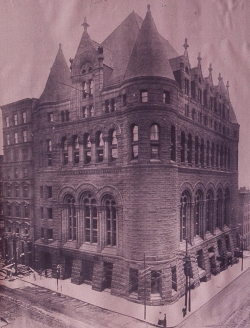
H.H. Richardson's Cincinnati Chamber of Commerce Building once stood on 4th Street downtown and was destroyed in a 1911 fire. photo/courtesy of UC Archives and Rare Books
The students also indicated they were hoping to establish a competition entitled “Operation Resurrection” to reuse the stones in a memorial to H.H. Richardson and the Chamber somewhere in Cincinnati. This effort was being spearheaded by then student Ted Hammer.
During the next two years, the effort moved forward under the direction of DAAP Professor John Peterson, while I remained on the faculty at Syracuse University.
A campaign to raise funds for the project was mounted by selling T-shirts, sweatshirts with hoods and lapel pins, each carrying the iconic image of H.H. Richardson.
A design competition for the memorial was held, and a site for the project was chosen in a triangular clearing formed by three large trees at the south end of Burnet Woods, opposite the north edge of the UC campus and the building complex of DAA.
A contest jury was assembled that included Boston-based architect Joe Richardson, grandson of H.H. Richardson. The memorial design by UC student Stephen Carter was selected, winning him a respectable (especially at that time) $3,000 first prize. Prizes were also presented for second place ($1,500) and third place ($500). The prize money was donated by a member of Cincinnati’s Fleischmann family.
At this point, the class of students who had worked on this project, including memorial designer Stephen Carter, graduated in spring 1969.
I had returned to UC’s faculty in fall 1968, and between 1968-70, important progress on the memorial was made. First, discussions with the Cincinnati Park Board resulted in an agreement to accept the stone’s placement in the park and a commitment to maintaining them once placed.
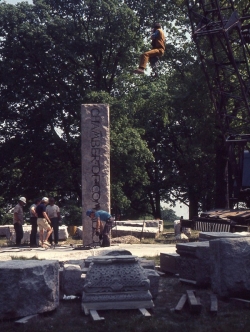
Workers install the stone relics of the Chamber of Commerce building in 1972. photo/courtesy of UC Archives and Rare Books
Second, a faculty member teaching a structures class designed the slab upon which the majority of the stones would be placed as well as the below-grade foundation upon which the iconic “Chamber of Commerce” lintel stone would rest in a vertical position, thus serving as the focus of the memorial. Third, student Robert Eury assumed the coordinating role (left unfilled by Ted Hammer’s graduation) and led a group of students interested in seeing the project completed.
Then, in May 1970, the Kent State shootings occurred, and campus unrest of the era continued. As a result, UC, like many other institutions, suspended classes.
Ironically this tragedy served to significantly benefit the Richardson Memorial project. During the ensuing week while the university was shut down but before the remainder of the spring term was cancelled, students received a commitment to pour the foundation and slab for the memorial. Hilltop Concrete Company provided concrete left from various runs, and students, along with a few skilled laborers, prepared the site, set forms and poured and finished the slab.
So, the basic “bedrock” for the resulting memorial was in place.
In fall 1971, when this group of students returned to the university, interest was high in seeing the stones placed and the memorial completed. Eury took the lead and approached the Cincinnati Chamber of Commerce to enlist participation in fundraising.
John Paul Jones, head of the Cincinnati Transit Company, took the lead in enlisting the Chamber’s participation in gathering both financial resources and in-kind hauling and construction expertise.
At this time the stones were gathered from around the Buffalo Ridge Road site to a central point for forwarding to the Burnet Woods site. All such moving of the stones on and from the site to Burnet Woods was provided by Fenton Rigging Company.
Thus, by spring 1972, all was in place to relocate the stones and complete the memorial. As noted in local newspaper photos, the project was in place by late May.

The newly installed plaque at the memorial details the background and principal donors involved with the project.
Subsequently, a formal dedication of the memorial along with expressions of appreciation and recognition of the participants and donors took place November 20, 1972. This event included the participation of Joe Richardson and the placement of a metal plaque of dedication/explanation about the Richardson Memorial.
One final coda to the story. Within a year, the plaque disappeared from the memorial.
However, a few years later, it surfaced when dorm rooms were being cleaned out at the end of the academic year, and the plaque was returned to the offices of the Department of Architecture. Unfortunately, the location of that original plaque is currently unknown.
However, with the 40th anniversary of the memorial’s completion fast approaching at the end of May 2012, Mary Peterson, widow of emeritus faculty John Peterson, and I joined forces to have a new plaque in cast bronze made and installed at the site to inform visitors of the stones’ history and significance.
Where are they now?
Ted Hammer today is the managing partner of HLW International, a multinational architectural firm of over 200 employees and a Fellow of the American Institute of Architects.
Robert Eury is the president of Central Houston, a public/private consortium that coordinates the redevelopment of downtown Houston, Texas.
Stephen Carter has his own consulting firm in Hilton Head, S.C., following a career as head designer and president of Lorenz Williams, Architects in Dayton, Ohio.
All three UC alums (as well as the above mentioned Donald Woodman) have had very distinguished professional careers that have built on the leadership promise suggested in their roles with the Richardson stones project. For those of us who chose a career in architectural education there can be no finer reward.
J. William Rudd is an emeritus professor and former dean of architecture at the University of Tennessee.
Parting shots

Stephen Carter returns in 2012 to visit the memorial he designed after winning a student design competition in the late '60s.
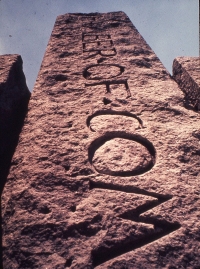
This 1972 image shows the tallest piece of the memorial. photo/courtesy of UC Archives and Rare Books
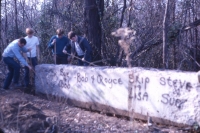
UC students work to prepare the stones for moving to Burnet Woods in '72. photo/courtesy of UC Archives and Rare Books
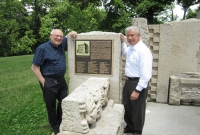
Former UC professor Bill Rudd and one-time student Stephen Carter reunited at the Burnet Woods memorial in June 2012.

Left to right: Richard Stevens, Robert Williams and John Peterson stand near the memorial soon after its completion.

